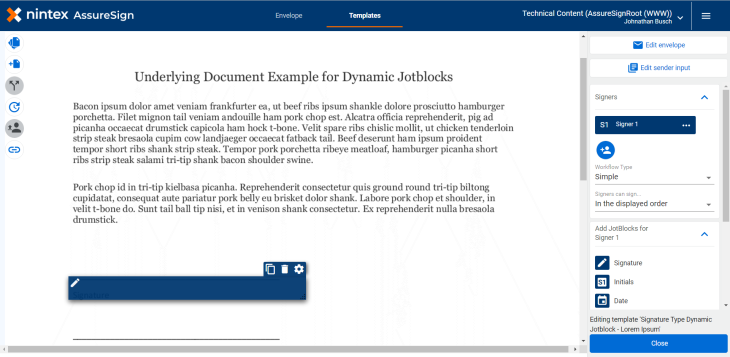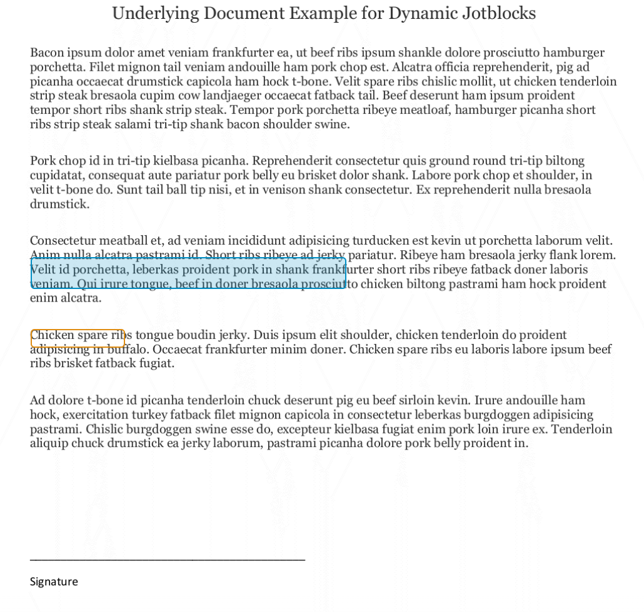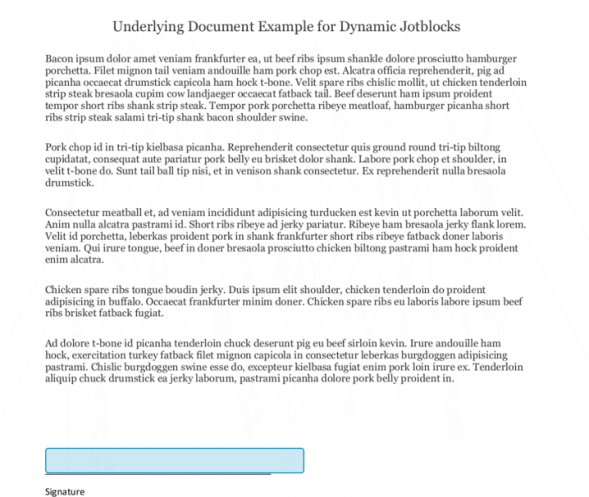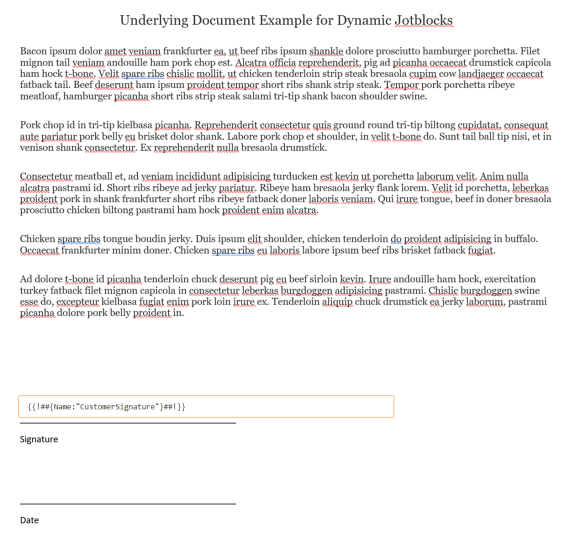Dynamic Jotblocks
Nintex eSign Dynamic JotBlocks allow you to create a large number of variations in the type of input you get from signers. Dynamic jotblocks allow you to put in one or more Jotblocks and have them adjust on the template dynamically based on the text contained on the envelope.
This section provides you with information in regards to dynamic jotblocks, and how they work differently than normal Jotblocks.
What is a Dynamic Jotblock?
Dynamic Jotblocks allow for scenarios where the underlying document itself changes during the signing workflow. Typically, this is a document generated within a third-party’s CRM system and paragraphs can be added to the initial document, thus lengthening the document by anywhere from a few lines to several paragraphs. This changes where the signatures and other Jotblocks are located on the final document sent out for signature. Dynamic Jotblocks change as the document changes, so that the Jotblocks added to the document are never covered up by additional text, or appear in somewhere that the creator of the Jotblock did not intend. For example, let's say you add a Signature type jotblock to a document that is going to be used by a legal team to review and then provide a signature. In this case as the document is sent out for review an addendum or additional clause is added to the end of the document. With the jotblock being dynamic the signature does not appear before this newly added content, instead it continues to appear at the end of the document as was originally intended. Refer to the example below to get a better understanding of how this would look in signing scenario.
How do I use a Dynamic Jotblock?
Dynamic jotblocks are a codified solution that requires the assistance of your development team. While adding the Jotblocks is done in the same way as it is when creating a new envelope or template, the act of making a Jotblock become a dynamic one requires adding code and passing an API call.
Adding a dyanmic jotblock to your document works in the same way as adding a standard jotblock. However, what makes a dynamic jotblock different is that it requires code that needs to be embedded into your document. This coding allows the jotblock to be moved around dynamically as the size of the document changes. Your development team should refer to Defining Jotblocks through Embedded Text Tags for more information on how to create the code.
Signature Type Example
In order to get a better understanding of how dynamic jotblocks work and function, let's take a look at the following example. This example shows the Signature Type Jotblock, and how to turn this jotblock into a dynamic one.
Create the Template
In most cases, a new template should be created in order to set up a document with dynamic jotblocks. For more information on how to create a new template refer to Simple Setup Templates.
The screen shot below shows a new template that has been created and contains a Signature Type Jotblock.

This is the template that would be used to send out an Envelope to several different users in a workflow. This workflow could contain different connectors, and different roles of users throughout the signing process.
Dynamic vs Non-dynamic Jotblock
So what happens if during the signing process an addendum or new information is added before this Signature Type Jotblock? Well one of your signers might get a document that looks something like this:

The blue box shows where the Signature Type Jotlock would end up. Since the Signature Type jotblock was not a dynamic jotblock, and therefore did not adjust with the new information. However, when the code has been added to turn the jotblock into a dynamic jotblock, the jotblock moves with any new information added:

Dynamic Jotblock Code
In order for a Jotblock to become a dynamic one, your development team provides you with the code necessary to insert into your document. What is this code and what does it look like? In order to get a better understanding of where this code needs to be inserted lets use the example of the Signature Type Jotblock as shown in the topics above. When a new dynamic jotblock is requested, lets say a dynamic jotblock is requested for the CustomerSignature jotblock in the examples above, you will receive code that looks like this:

This code then needs to be inserted into the document where the Signature Type Jotblock is located:

Now that this code has been inserted into the document, when this document is sent out for signing, the Signature Type Jotblock that is added is now going to move based on any new text or information that gets added during the signing process. To the user signing the document, they do not see anything different, and the signing process continues like any normal signing process.